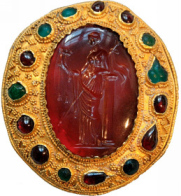Five out of the ten versions of Scripture used for comparison purposes in this series translate odem in Exodus 28:17 as "sardius." Two versions translate the word as carnelians and three call it a ruby.
The first gemstone listed in the Bible that God used to beautify Lucifer (Ezekiel 28:13) is also referred to as an odem. Four of our Biblical versions call this stone a ruby, four label it as a sardius and two call it carnelians. The terms "sardius" or "sard," according to various sources (Wikipedia, Curious Lore of Precious Stone (page 290), Catholic Encyclopedia, etc.) refer to carnelians gems.
The sixth foundation stone of New Jerusalem (Revelation 21:20) is called in the Greek sardios (Strong's #G4556). It is translated as "sardius" in half of the Bible translations used in this series while the other half translate it as "carnelians."
It is almost certain that the first stone in the High Priest's breastplate was not a ruby but rather another blood-red precious stone. This is because rubies, which are one of the hardest minerals known to man, would have been near impossible for ancient Israelites to engrave.

According to the book "Gemstones in the Breastplate," no evidence exists that suggests the ancient Israelites (who, around 1445 B.C., left Egyptian slavery) had the technology to engrave a mineral as hard as a ruby (page 13). It must be admitted, however, that the first stone used to adorn Lucifer may have been a ruby, since it was God who directly used it to make him beautiful.
Link to Abraham
The Mesopotamian city of Ur (also known as Ur of the Chaldees) was the patriarch Abraham's hometown. He lived in the city for seventy years, from 1960 to 1890 B.C., until God told him to leave in order to inherit the Promised Land (land of Canaan).
The ancient tombs of Ur were discovered in 1922 by Leonard Woolley who was the head archaeologist on the site. His work uncovered a cache of skeletons dating back at least to the time of Abraham. Among the skeletons were found headdresses made of carnelian and lazuli stones (Bible Lands: An Illustrated Guide to Scriptural Places, pg. 12).
Folklore
Carnelians were frequently used in amulets and as a talisman. They were thought, like jasper, to have the ability to stop the hemorrhaging of blood. This gemstone was also thought to bring good luck and to keep the wearer safe from injury from falling houses or walls. This, and other red stones, were additionally worn for their perceived benefit in making the wearer a better and bolder speaker.
Tradition states that Muhammad (founder of Islam) wore on his right hand's little finger an engraved ring containing carnelians that he used as a seal (Curious Lore of Precious Stones, pages 62 - 64).